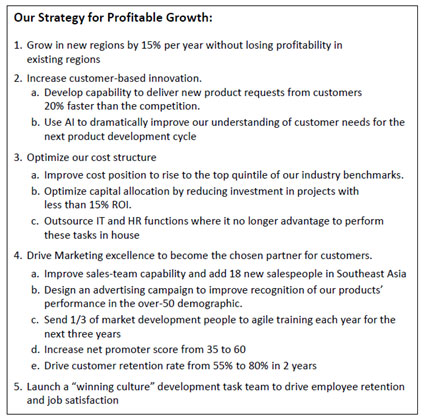Which of 8 Definitions of Strategy are You Using?

Despite how much is written about strategy and how much money is spent on it, academics and consultants continue to report chronic strategy practice failures:
I argue that one reason for the failures is that strategy is still not fully defined. I’ve collected 75 concepts and definitions of strategy from authorities in multiple fields (see them on emergentapproach.com/supplement). Opinions of the writers vary widely, but the majority of what they propose as a definition of strategy can be captured in eight concepts:
- Aspirations
- What is long-term, big, or important
- Plans
- Master plans (frameworks)
- Choices
- Defined by requirements
- Patterns and actual outcomes
- Rules and policies
Aspirations, the first category, including goals, visions, or missions, cannot be strategies because strategy is for achieving aspirations. Yet a vast number of strategies consist of lists of subgoals arranged in “strategy themes:”
Such lists are seductive because they give the illusion of improving every aspect of the company. But granularizing overall goals into subgoals does not inform the organization how to make coherent decisions towards overall aspirations.
In many definitions, strategic is equated with anything long-term, big or important. But your aspiration—not strategy—determines your endeavor’s time horizon, size, and importance. If you aspire to achieve something in 10 months, your strategy horizon is 10 months. Defining strategy as “long-term” can mislead people into believing that strategy is not relevant in turbulent periods. Yet turbulent periods are precisely when a guiding strategy is needed.
The third definition is strategy as plans. A plan is an intended set of actions; do something by a specific date. Plans are valuable for coordination and synchronization, road-mapping, and reality testing of a strategy framework, but they cannot be strategies because they give insufficient real-time guidance to the organization for making coherent decisions. Strategy as plans also implies that you know in advance how to get from your current to your future state. Yet military wisdom says that a plan never lasts longer than the first engagement with the enemy—a strategy should last longer than the first engagement. It is plans that are not useful in turbulent times.
The fourth definition is a larger sense of “plan” that means the collection of not only plans as future actions, but also tactics, scenarios, value propositions, organization and budgets, metrics, and even the aspirations—collectively describing “what the organization wants to be and how to get there.” This is a strategy framework, also called a master plan or a strategic plan. Often, the one component missing in the “strategic plan” is the strategy.
Michael Porter presented the fifth definition of strategy in his groundbreaking 1996 paper What is Strategy? Yet, he never actually defines strategy. He never says a strategy is a ________. He does state that strategy is what gives a unique competitive position for the company and that it must create fit between the various functions of an organization and other requirements. But requirements, no matter how important, don’t define strategy. An automobile motor may need to be efficient, easy to manufacture, and robust to severe weather, but these don’t define a motor. These could be requirements for the car’s air conditioner just as well. Strategy is defined by its function.
The sixth definition of strategy is the idea of choice or the act of making choices. Certainly, deciding on a strategy that meets important requirements, such as established by Porter, is a choice, a difficult choice with tough trade-offs. But every component of your framework—goals, missions, metrics, tactics, budgets, plans, organization structure, vendors, and on and on—are important choices too, so there must be something more than “choice” to define the strategy component. Also, a strategy must be a tangible concept that the organization can internalize, not an act.
Strategist Henry Mintzberg established the seventh definition of strategy. In his frustration that leaders don’t see the disconnect between what people say their strategy is and what actually happens, he defined strategy as a pattern or actions taken. Mintzberg has been a leading voice in demanding an adaptive view of innovation. However, a strategy guides decisions and actions to achieve aspirations; it is not the future patterns or the choices themselves. For a strategy to have value, you must state it before results are in, even if the strategy is changed frequently. Further, just because employees don’t adhere to a strategy does not mean it isn’t a strategy.
The eighth of the concepts offered in the literature leads to the true definition of strategy. A strategy is a rule, or more specifically (aligned closely with Richard Rumelt’s “central policy”) a strategy is the central rule of a framework, designed to unify all decisions and actions around busting the bottleneck to achieving aspirations. If the strategy rule is adhered to, the probability of achieving aspirations increases.
Rules may sound the opposite of what would lead to creativity and innovation. They may conjure bureaucracy. How could rules lead to innovations, diversity, growth, and newness? Yet rules are the powerful enablers of adaptation and freedom because they provide real-time guidance for decision-making without overconstraining. Plans and subgoals say what must occur; rules can specify boundaries of what cannot or should not occur. Plans are prescriptive, rigid, requiring prediction and detail. Rules leave people free to discover the future.
So, instead of lists of subgoals and plans, designing a true strategy rule will force facing what is in the way of progress against your overall aspirations—the bottleneck. If your aspiration is to grow in new regions, and the bottleneck is your product line has become too complicated and bloated and therefore costly, your strategy rule may force you to stop serving specific customers, applications, or regions. If the bottleneck is that you don’t have the right products or presence in the target new region, your rule may force you to give some equity away to gain a partnership. If your bottleneck is a lack of personnel with digital capability and you need to implement digital in both existing and new regions, you may have to create a strategy that limits the number of people you are willing to pay and the number of programs you can allow in R&D, manufacturing, and other functions.
In every case, a real strategy rule will have painful trade-offs. If it does not, then it’s not a strategy. And a real strategy might not sound interesting to someone looking from the outside if they are not experiencing what you are up against. Generating a list of subgoals bypasses the pain of trade-offs and dilutes the focus on the bottleneck. When everything matters, nothing really matters.
Of course there much more to designing a strategy framework and all of its components, but diagnosing the bottleneck and a central rule to address it is core to focusing resources.
Written by Peter Compo.
Have you read?
# Best CEOs In the World Of 2022.
# TOP Citizenship by Investment and Residency by Investment Programs, 2022.
# Global Passport Ranking, 2022.
# The World’s Richest People (Top 100 Billionaires, 2022).
# Best Novels to Read of 2021.
# Economy Rankings: Largest countries by GDP, 2022.
Add CEOWORLD magazine to your Google News feed.
Follow CEOWORLD magazine headlines on: Google News, LinkedIn, Twitter, and Facebook.
This report/news/ranking/statistics has been prepared only for general guidance on matters of interest and does not constitute professional advice. You should not act upon the information contained in this publication without obtaining specific professional advice. No representation or warranty (express or implied) is given as to the accuracy or completeness of the information contained in this publication, and, to the extent permitted by law, CEOWORLD magazine does not accept or assume any liability, responsibility or duty of care for any consequences of you or anyone else acting, or refraining to act, in reliance on the information contained in this publication or for any decision based on it.
Copyright 2024 The CEOWORLD magazine. All rights reserved. This material (and any extract from it) must not be copied, redistributed or placed on any website, without CEOWORLD magazine' prior written consent. For media queries, please contact: info@ceoworld.biz
SUBSCRIBE NEWSLETTER










